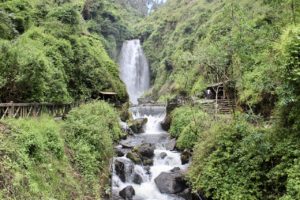Ecosystem shows resilience to prolonged human modification
Cloud forests of Ecuadorian Andes not as pristine as previously thought.
University of Amsterdam—Nineteenth century explorers who visited the cloud forests of the Ecuadorian Andes regularly referred to the landscape as a ‘pristine’ wilderness. What they were, in fact, observing was the recovery on an environment that had previously been heavily cultivated and deforested by the indigenous population for hundreds of years. In an article* published in the journal Nature Ecology and Evolution, an international team of researchers from the University of Amsterdam (UvA), The Open University (UK) and the Institute of Earth Sciences Jaume Almera – CSIC (Spain) throws new light on the resilience of biodiverse ecosystems to prolonged human modification.
The cloud forests of the Andes are some of the most biodiverse and endangered terrestrial environments on earth. ‘If we want to successfully conserve and restore these forests, it is essential to understand their history’, says palaeoecologist Will Gosling from the UvA’s Institute for Biodiversity and Ecosystem Dynamics (IBED). ‘For our project, we reconstructed the last 1000 years of changing human impact on the cloud forests of Ecuador in the Quijos Valley, a vital trade route between the Incan Empire and the indigenous peoples of the Amazon region. The Quijos Valley was a route Spanish conquistadors took when travelling into the Amazon in search of gold, silver and cinnamon.’
Catastrophic depopulation
Using a floating platform, the researchers extracted sediments from a lake, radiocarbon dated to cover the last 1000 years. Using pollen, fungal spores and charcoal preserved in the sediment the researchers reconstructed the historical landscape, comparing it to the modern environment and to a period before the first humans arrived in the Americas.
Prior to the arrival of European colonisers, the indigenous population intensively cultivated and managed the land. Their intensive land-use deforested the region to a greater extent than modern cattle farming. However, this ended abruptly around AD 1588 following the catastrophic decline of the indigenous peoples as result of European colonisation. ‘It subsequently took the cloud forest about 130 years to recover and return to the structural equivalent of a ‘pre-human arrival’ forest’, says Nicholas Loughlin, a researcher at The Open University who led the project as part of his PhD. ‘The 19th century explorers who described a ‘pristine’ wilderness were unknowingly observing a ‘shifted’ ecological baseline that was, in fact, influenced by centuries of previously unseen human activity.’
Hope for restoration
These findings offer hope that areas degraded by intensive agriculture can be restored as well as provide a unique insight into the culture of indigenous populations in the Americas. Gosling: ‘Our study focused exclusively on the Quijos Valley. A question that remains is how characteristic this region is of the Andes as a whole. Our aim is to expand the scope of our research across the eastern Andean cloud forests of Ecuador.’
__________________________

Cloudforest waterfall, in an environment not as pristine as previously thought. CC0 Creative Commons
__________________________
*Nicholas J.D. Loughlin, William D. Gosling, Patricia Mothes & Encarni Montoya: ‘Ecological Consequences of Post-Columbian Indigenous Depopulation in the Andean-Amazonian Corridor’, in: Nature Ecology and Evolution, 16 July 2018. DOI: 10.1038/s41559-018-0602-7
__________________________



